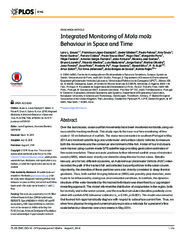Integrated Monitoring of Mola mola Behaviour in Space and Time
Permanent link
https://hdl.handle.net/10037/9652Date
2016-08-05Type
Journal articleTidsskriftartikkel
Peer reviewed
Author
Sousa, Lara L; López-Castejón, Francisco; Gilabert, Javier; Relvas, Paulo; Couto, Ana; Queiroz, Nuno; Caldas, Renato; Dias, Paulo Sousa; Dias, Hugo; Faria, Margarida; Ferreira, Filipe; Ferreira, António Sérgio; Fortuna, João; Gomes, Ricardo Joel; Loureiro, Bruno; Martins, Ricardo; Madureira, Luis; Neiva, Jorge; Oliveira, Marina; Pereira, João; Pinto, José; Py, Frederic; Queirós, Hugo; Silva, Daniel; Sujit, P. B.; Zolich, Artur Piotr; Johansen, Tor Arne; Sousa, João Borges de; Rajan, KannaAbstract
Over the last decade, ocean sunfish movements have been monitored worldwide using various satellite tracking methods. This study reports the near-real time monitoring of fine-scale (< 10 m) behaviour of sunfish. The study was conducted in southern Portugal in May 2014 and involved satellite tags and underwater and surface robotic vehicles to measure both the movements and the contextual environment of the fish. A total of four individuals were tracked using custom-made GPS satellite tags providing geolocation estimates of fine-scale resolution. These accurate positions further informed sunfish areas of restricted search (ARS), which were directly correlated to steep thermal frontal zones. Simultaneously, and for two different occasions, an Autonomous Underwater Vehicle (AUV) video-recorded the path of the tracked fish and detected buoyant particles in the water column. Importantly, the densities of these particles were also directly correlated to steep thermal gradients. Thus, both sunfish foraging behaviour (ARS) and possibly prey densities, were found to be influenced by analogous environmental conditions. In addition, the dynamic structure of the water transited by the tracked individuals was described by a Lagrangian modelling approach. The model informed the distribution of zooplankton in the region, both horizontally and in the water column, and the resultant simulated densities positively correlated with sunfish ARS behaviour estimator (rs = 0.184, p<0.001). The model also revealed that tracked fish opportunistically displace with respect to subsurface current flow. Thus, we show how physical forcing and current structure provide a rationale for a predator’s fine-scale behaviour observed over a two weeks in May 2014.
Description
Publisher's version, source: http://dx.doi.org/10.1371/journal.pone.0160404.


 English
English norsk
norsk